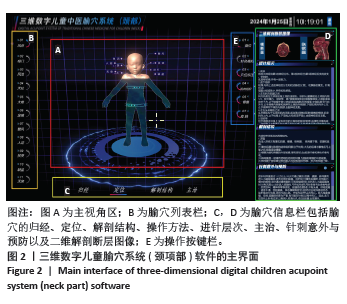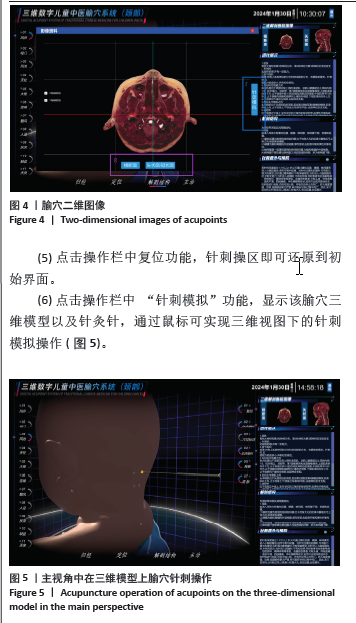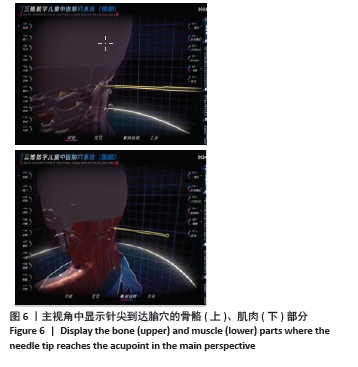中国组织工程研究 ›› 2025, Vol. 29 ›› Issue (9): 1834-1840.doi: 10.12307/2025.149
• 数字化骨科Digital orthopedics • 上一篇 下一篇
儿童颈项部腧穴三维数字可视化系统研发与应用
奥晓静,李 琨,刘宇航,杨潇暄,王 星,李志军,任小燕,张少杰
- 内蒙古医科大学,1中医学院,2基础医学院解剖学教研室,内蒙古自治区呼和浩特市 010110;3内蒙古医科大学研究生院,内蒙古自治区呼和浩特市 010000;4内蒙古触点数字科技有限公司,内蒙古自治区呼和浩特市 010020;5内蒙古医科大学数字医学中心,内蒙古自治区呼和浩特市 010059;6内蒙古医科大学附属医院内分泌科,内蒙古自治区呼和浩特市 010059
Development and application of a three-dimensional digital visualization system for children’s neck acupoints
Ao Xiaojing1, Li Kun2, Liu Yuhang3, Yang Xiaoxuan4, Wang Xing5, Li Zhijun2, Ren Xiaoyan6, Zhang Shaojie2
- 1College of Traditional Chinese Medicine, Inner Mongolia Medical University, Hohhot 010110, Inner Mongolia Autonomous Region, China; 2Department of Anatomy, School of Basic Medicine, Inner Mongolia Medical University, Hohhot 010110, Inner Mongolia Autonomous Region, China; 3Graduate School of Inner Mongolia Medical University, Hohhot 010000, Inner Mongolia Autonomous Region, China; 4Inner Mongolia Chudian Digital Technology Co., Ltd., Hohhot 010020, Inner Mongolia Autonomous Region, China; 5Digital Medicine Center of Inner Mongolia Medical University, Hohhot 010059, Inner Mongolia Autonomous Region, China; 6Department of Endocrinology, Affiliated Hospital of Inner Mongolia Medical University, Hohhot 010059, Inner Mongolia Autonomous Region, China
摘要:
文题释义:
数字可视化:利用计算机图形学和图像处理技术,将数据转换成图形或图像在屏幕上显示出来,并进行交互处理的理论、方法和技术。
腧穴:也被称为穴位,是人体脏腑经络之气输注于体表的部位,是针灸治疗疾病的刺激点、反应点。
摘要
背景:目前已有成人腧穴三维数字化、可视化系统的相关研究,但基于真实儿童数字化断层解剖数据集对儿童腧穴可视化相关的研究报道并不多见。
目的:设计研发儿童颈项部腧穴数字三维可视化系统,为针灸学、经络腧穴学教学、针灸临床、针刺施术手法练习及针刺安全性研究提供依据,并为研发儿童腧穴仿真系统提供基础。
方法:基于真实学龄前男童断层解剖数据集,运用PhotoShop 2021与Digihuman Reconstruction System软件完成儿童颈项部三维数字化虚拟解剖模型及内部多器官三维重建;通过Unity数据库语言编制风府、风池等11个腧穴的数据库;在Unity3D 软件中整合儿童颈项部解剖立体模型、腧穴数据库及编写针刺操作代码,成功创建集仿真腧穴定位、三维腧穴解剖、针刺训练、临床教学及针刺安全性研究等多功能于一体的儿童颈项部腧穴三维数字可视化系统。
结果与结论:①该研究基于真实儿童标本,采用手动逐层分割断面图像法以最大程度确保3D模型精度。使用3D 软件 Digihuman Reconstruction System提取和保存独立分割数据,与PhotoShop 2021软件共同完成儿童颈项部外层皮肤与其内部骨性结构、颈部脊髓、血管和神经、肌肉及韧带等数十个三维重建解剖结构模型。于MeshLab软件中完成各独立结构基本形态和整体轮廓完整性核验工作,并利用3-matic research 13.0软件进行最终精细化调校及解剖位置确认,成功模拟还原学龄前儿童颈项部真实解剖形态。②依据并参考中华人民共和国国家标准收集整理儿童颈项部常用腧穴的名称、所属经脉、定位、局部解剖、进针层次、针刺方法、针刺意外与预防、腧穴主治、二维解剖断层图像等8个方面内容形成腧穴数据库。③运用Unity3D 软件将儿童颈项部三维模型、针刺模拟操作和腧穴数据库三者整合,成功构建三维数字儿童颈项部腧穴可视化系统。该系统可显示儿童颈项部腧穴的信息、二维三维解剖结构,并实现了儿童颈项部腧穴的二维、三维针刺模拟功能及针刺安全性研究功能。基于真实儿童标本超薄断层解剖数据集,构建了首个儿童颈项部腧穴三维数字化、可视化系统,较既往腧穴系统更贴合亚洲儿童的解剖形态学发育特点,在针刺安全性研究、临床教学及针刺模拟训练等领域具有极高的应用价值。
中国组织工程研究杂志出版内容重点:人工关节;骨植入物;脊柱;骨折;内固定;数字化骨科;组织工程
中图分类号:



